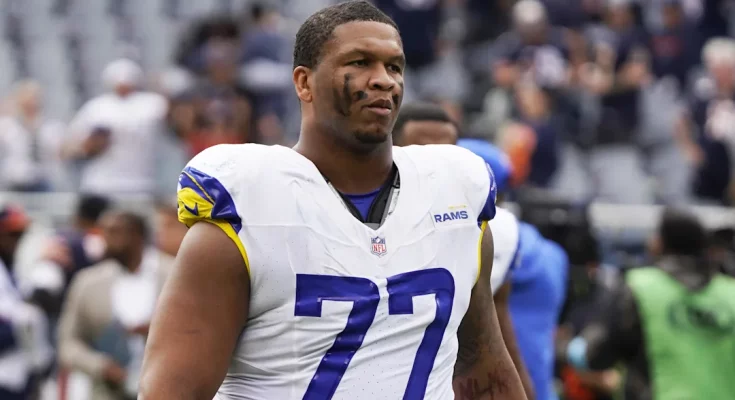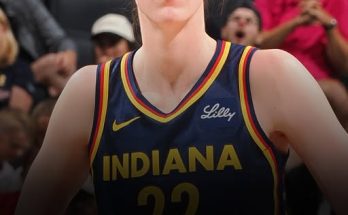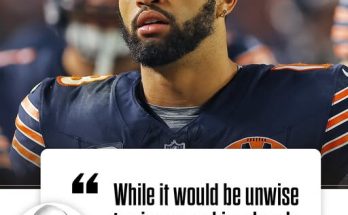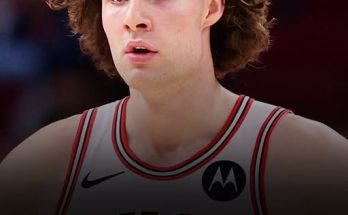The Los Angeles Rams have released a much-anticipated injury update on starting left tackle Alaric Jackson, a development that comes with serious implications not only for the Rams’ offensive line but for the overall dynamics of their 2025 NFL campaign. For fans, analysts, and aspiring athletes, injury updates like these aren’t just bits of team news—they’re windows into how the professional football machine operates when one of its vital parts begins to falter. The report on Jackson reminds everyone how fragile the balance between dominance and disaster can be in the trenches.
Alaric Jackson has quietly become a foundational piece of the Rams’ offensive puzzle. Undrafted out of Iowa in 2021, he’s one of those rare players who defies the odds by not only earning a roster spot but clawing his way into a starting role. He has proven himself time and again to be resilient, technically sound, and gritty—a lineman who doesn’t often get mentioned on highlight reels, but whose name is known very well by every defensive end who’s had to square off with him. The 6’7”, 285-pound Canadian-born tackle carved his path by protecting Matthew Stafford’s blind side with consistency and power, a critical assignment in Sean McVay’s play-action-heavy scheme.
So, when news broke earlier this week that Jackson had left practice early and was listed on the team’s official injury report, alarm bells began to ring—not just in the Rams’ front office, but throughout Rams Nation. The initial speculation was wide-ranging. Given the physical toll the tackle position demands, especially from a player who has logged heavy snaps over multiple seasons, it was unclear whether Jackson was dealing with a minor tweak or something more severe. The Rams have since clarified that Jackson is dealing with a moderate-grade ankle sprain, an injury that, while not season-ending, is more than a nuisance in the context of the team’s offensive preparations.
Understanding the gravity of Jackson’s injury requires a deeper look into both his role on the field and the nature of the injury itself. A moderate ankle sprain generally falls into what medical professionals classify as a Grade 2 sprain. This means there has been partial tearing of the ligament, leading to moderate swelling, instability, and a general timeline for return that could range from two to six weeks, depending on the individual and the rehab protocols followed. For a lineman like Jackson, whose position requires constant lateral movement, leverage battles, and anchoring against 280-pound pass-rushers, the ankle’s stability is absolutely crucial.
The Rams medical staff reportedly caught the injury early and have already begun an aggressive treatment and rehabilitation plan. According to internal sources close to the team, Jackson is expected to be evaluated weekly, with a return-to-play goal set somewhere between Weeks 2 and 4 of the preseason. However, the Rams are taking a precautionary stance. With Jackson already entrenched as the starting left tackle and with no urgent need to rush him back into preseason action, there is growing expectation that the Rams may elect to rest him through the majority of preseason to ensure he’s fully ready for Week 1.
This cautious approach speaks to a larger philosophy that has been adopted by many NFL franchises in recent years, particularly those with playoff ambitions. The preseason, while useful for player evaluations and game-speed conditioning, often exposes key players to unnecessary risk. In Jackson’s case, the coaching staff has already seen enough of his tape and practice reps to know what he brings to the field. For him, recovery now becomes the top priority.
But injuries like this one raise bigger questions about the fragility of NFL rosters, particularly at the offensive line position, where depth is a perennial concern. The Rams are no exception. Beyond Jackson, the depth chart at tackle includes names like Joe Noteboom, who has been in and out of the lineup due to his own injury issues, and rookie Ethan Whiteside, a third-round pick out of North Carolina State. While Whiteside has shown flashes in OTAs and early training camp, he remains raw—especially in terms of technique against NFL-level speed and power. If Jackson were to miss significant time, the Rams would be forced to either start a rotational-level veteran or throw a rookie into the fire, neither of which is ideal when you consider the gauntlet of elite edge rushers in the NFC West.
From a tactical standpoint, Jackson’s absence would alter the complexion of the Rams’ offensive game plan. Sean McVay’s offense, at its best, relies on the run-pass balance that only comes when the line is playing cohesively. The outside zone scheme that has become synonymous with McVay’s system requires not only power but synchronicity, especially from the left side. Jackson, with his long arms and nimble footwork, has become adept at sealing edges and creating the lanes needed for Cam Akers and Kyren Williams to find daylight. Without him, the Rams might lean more on quick-hit passes or move the pocket more frequently to compensate for potential edge pressure.
Additionally, Matthew Stafford is entering the 2025 season with durability questions of his own. Having battled through elbow and shoulder issues the last two seasons, Stafford is not a quarterback who can afford to absorb unnecessary hits. Jackson’s protection is critical to keeping Stafford upright and effective. Losing a player like Jackson, even temporarily, puts a strain on the entire offensive mechanism—something no team with playoff aspirations wants to deal with before the season even kicks off.
Alaric Jackson’s road to recovery is also a window into how NFL franchises use their vast medical and training resources to rehabilitate players efficiently and thoroughly. Modern rehab doesn’t just include rest and icing. The Rams’ training staff are likely employing an intricate mix of cryotherapy, electrostimulation, balance and proprioception exercises, underwater treadmill work, and perhaps even platelet-rich plasma (PRP) injections to accelerate healing. Recovery isn’t just about physical healing anymore—it’s about ensuring the injured athlete regains peak performance ability without sacrificing future health.
What sets Jackson apart is his work ethic. Those who know him from his days at Iowa recall a player who never took a day off, who always stayed after practice to work on foot placement and hand strike, and who treated each play like it could be his last. That mindset hasn’t changed in the pros. Early reports from within the facility suggest that Jackson has already begun light range-of-motion drills and is eager to begin jogging within the next week. The goal is to test the joint’s response to movement without putting him at risk of re-injury. How his ankle responds to these initial tests will determine when he can begin full-speed lateral work—a necessary prerequisite to returning to the line.
The Rams, meanwhile, are preparing for multiple scenarios. Offensive line coach Ryan Wendell, himself a former NFL lineman, has been tasked with increasing cross-training among the remaining tackles and guards to ensure flexibility. In practices, we’re seeing players rotate through multiple positions—not just to find a backup for Jackson but to identify any hidden depth that might be developed under pressure. It’s a common practice in the NFL to groom ‘swing tackles’—players who can play both left and right tackle in a pinch. In this case, someone like Noteboom or even veteran journeyman Bobby Evans could be tasked with taking over for Jackson temporarily if needed.
Still, the Rams’ decision-making around Jackson’s return will likely be influenced by their early-season schedule. Their first few opponents include two teams known for defensive pressure—one being the San Francisco 49ers, whose defensive line led by Nick Bosa can wreak havoc on unprepared offensive fronts. If Jackson is still not at 100% by that game, the Rams may err on the side of caution rather than send him into the fire prematurely. This reflects a broader shift in how NFL teams now value long-term availability over short-term risk.
Fans are often quick to judge players for “not playing through pain,” but there’s a fine line between toughness and recklessness. The truth is, most NFL linemen play hurt at some point in the season—it’s just the nature of the beast. But managing injury, especially when it concerns a player as critical as Jackson, requires a combination of science, intuition, and trust between the player and medical staff.
Jackson’s injury also provides a teachable moment for younger players and fans alike about the nature of offensive line play. Unlike skill positions where performance can be measured in catches or touchdowns, linemen live in the grey areas of football—their success measured by absence: absence of pressure, absence of sacks, absence of hits. It’s a job where perfection is expected but rarely noticed. And when someone like Jackson goes down, the spotlight doesn’t shine on him—it shines on whoever fails to replace him adequately.
For young offensive linemen studying the NFL, Jackson’s journey and recovery will be a lesson in professionalism. He wasn’t a blue-chip recruit. He didn’t go in the first round. He didn’t have a viral draft night. But through preparation, consistency, and toughness, he became a cornerstone. Now, as he battles through this setback, he’ll likely show those same qualities again, this time off the field.
Ultimately, while the Rams’ update on Alaric Jackson confirms that the injury is manageable, it serves as a broader reminder of just how fragile success in the NFL can be. Every team enters the season with dreams of a playoff run, a deep roster, and an ironclad scheme. But it only takes one rolled ankle in training camp to cause a ripple effect that challenges everything.
For now, Rams fans can breathe a small sigh of relief knowing that their starting left tackle won’t need surgery and should return relatively soon. But as every lineman knows, the work doesn’t stop because you’re hurt—it just changes shape. And for Alaric Jackson, that new shape involves ice packs, band resistance, physical therapy routines, and the mental grind of rehab. If his past is any indication, he’ll meet that challenge with the same resolve he’s always shown—quietly, confidently, and ready to anchor the Rams’ line again when his number is called.



